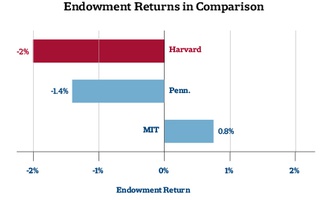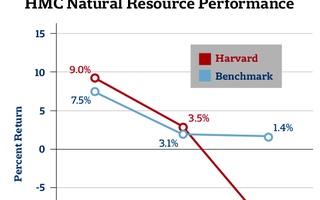{shortcode-f707cebef8d7b043ad6160efd94eaf039b54815f} In his annual endowment report Harvard Management Company CEO N.P. Narvekar didn’t equivocate about the “deep structural problems” at the firm. What was less clear, though, was exactly what comprises the investment portfolio that Narvekar seeks to overhaul.
In a departure from tradition, notably absent from the annual endowment report HMC released Tuesday was a dissection of the assets that comprise its portfolio. The absence of quantitative details may further obscure the composition of the firm’s portfolio, exacerbating long-standing concerns that HMC is not transparent enough.
Also missing from the endowment report was a discussion of the investment benchmarks the firm hit or missed in fiscal year 2017. A 2015 McKinsey and Company review of HMC blamed easily attainable benchmarks—which it labeled “‘slow rabbits’”—for creating a complacent culture at the firm.
HMC spokesperson Emily Guadagnoli wrote in an email Tuesday that there is “no additional data to provide” on the status of the endowment beyond Narvekar’s letter, which reported that the endowment posted “disappointing” 8.1 percent returns.
Narvekar offered an explanation for the change, writing that HMC would be shifting from traditional “asset allocation” and towards a “risk allocation strategy.” The shift in terminology is consistent with Narvekar’s approach to the endowment, which aims to manage risk across the fund instead of dividing assets into categories.
Narvekar argued the move towards a risk allocation model will allow HMC to better understand how exposed the endowment is to market fluctuations. It will also help the firm make long-term assumptions about its investments, rather than responding to day-to-day market moves or short-term returns on certain assets, he wrote.
In the two letters he’s released to the public since the start of his tenure last December, Narvekar has written extensively about the firm’s ongoing project to identify an appropriate level of risk for Harvard, repeatedly cautioning against making hasty comparisons between Harvard and other universities.
“Comparisons to other peers are natural, but not productive,” Narvekar wrote. “A more sophisticated lens will always focus first upon risk appetites rather than simply returns.”
According to financial headhunter Charles A. Skorina, who regularly writes on the performance of top institutional investors, the shift toward this risk model is not unusual.
“A number of big endowments are going towards a different type of allocation terminology. Instead of equities, debt, private equity, etc, they’re going for classifications like ‘high-earning assets’, risk-mitigation assets, and so on,” he said. “Some of the literature says that it helps people understand how their portfolio’s going to react in a recession, for instance, or in a bull market.”
Harvard’s fiscal year 2017 returns pulled the firm back into the black, after it returned negative 2 percent the year prior. Still, Harvard continues to lag behind its peers: Dartmouth, the other Ivy League whose investment returns have been reported, yielded 14.6 percent in fiscal year 2017 amid strong public markets.
—Staff writer Brandon J. Dixon can be reached at brandon.dixon@thecrimson.com. Follow him on Twitter @BrandonJoDixon.
Read more in News
Maps Exhibit at Pusey Library to End Next WeekRecommended Articles
-
 Harvard Loses Almost $2 Billion in Endowment Value
Harvard Loses Almost $2 Billion in Endowment Value -
The Urgency of the PresentAs crass as it might be to say, money makes Harvard go round.
-
 HMC to 'Refine' Natural Resources Investing
HMC to 'Refine' Natural Resources Investing -
Harvard’s Endowment Plans to Sell $70 Million of Cows and Farmland AssetsNot even Harvard’s cows are safe as Harvard Management Company undergoes a radical restructuring that it hopes will reverse a decade of lackluster returns.
-
 Entire Ivy League Outpaces Harvard Endowment in Fiscal Year 2017
Entire Ivy League Outpaces Harvard Endowment in Fiscal Year 2017













